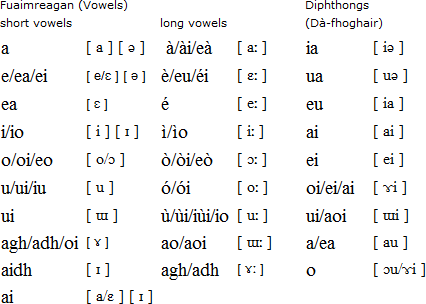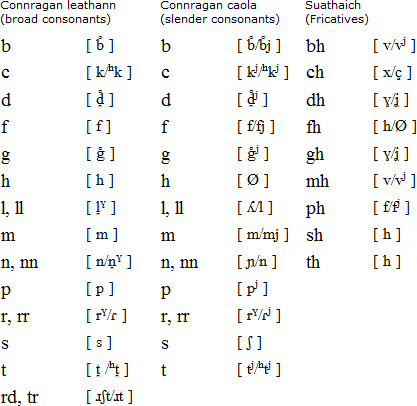




Scottish Gaelic (Gàidhlig)
http://www.omniglot.com/writing/languages.htm.It was clear to me when I arrived in Devon after being 18 years in Birmingham that the English language is not something that is taught in schools but rather moderated by the education in school.
Devon had for many centuries a different language as did Cornwall, Wales, Scotland and I felt when I was in the East End of London that they too had a language seperate to others. Devon to London, Weardale to Northumberland, Newcastle and Gateshead to Edinburgh, Edinburgh to Salvador and I have now got France as part of my life, its the same language but with significant differences which can be, inicially, off putting but with a bit of persistance its not impossible to communicate with the world. I have just found this sight and wish to throw its doors open to every one.
There's more to this green and soulful country than just daffodils. In many ways, Wales is just what you picture it to be: rolling moorlands, glaciated mountain areas, mellifluous male-voice choirs, tongue-twisting place names, Rugby Union, 'Bread of Heaven', romantic castles, people with querying lilts, cheese on toast and old mining towns. I have memories of Wales from my youth, my parents had friends of the family that lived there and we would often spend holidays on the coast of Wales at Aberdovey. At school I made one trip to the base of Snowden the Welsh mountain, this was winter time and the area was covered in a blanket of snow, I had gone there with two friends from school with the intention to camp for the weekend at the base of the mountain. It was freezing.
Bagpipes, Braveheart and the bonnie banks of Loch Lomond. Think you know everything there is to know about Scotland's history, tradition and roots? Think again.
http://www.youtube.com/watch?v=x8OXbctQwXA for some sounds of ScotlandThe prickly purple thistle was adopted as the Emblem of Scotland during the rein of Alexander III (1249 -1286). Legend has it that an Army of King Haakon of Norway, intent on conquering the Scots landed at the Coast of Largs at night to surprise the sleeping Scottish Clansmen. In order to move more stealthily under the cover of darkness the Norsemen removed their footwear.
As they drew near to the Scots it wasn't the only thing hiding under the cover of darkness. For one of Haakon's men unfortunately stood on one of these spiny little defenders and shrieked out in pain, alerting the Clansmen of the advancing Norsemen. Needless to say the Scots who won the day.
Scottish Gaelic is spoken by about 60,000 people in Scotland (Alba), mainly in the Highlands (a' Ghaidhealtachd) and in the Western Isles (Na h-Eileanan an Iar), but also in Glasgow (Glaschu), Edinburgh (Dùn Eideann) and Inverness (Inbhir Nis). There are also small Gaelic-speaking communities in Canada, particularly in Nova Scotia (Alba Nuadh) and on Cape Breton Island (Eilean Cheap Breatainn). Other speakers can be found in Australia (Astràilia), New Zealand (Sealainn Nuadh) and the USA (Na Stàitean Aonaichte).
Scottish Gaelic is closely related to Manx and Irish and was brought to Scotland around the 4th century AD by the Scots from Ireland. Scottish Gaelic was spoken throughout Scotland (apart from small areas in the extreme south-east and north-east) between the 9th and 11th centuries, but began to retreat north and westwards from the 11th century onwards. All Scottish Gaelic dialects are mutually intelligible, and written Irish can be understood to a large extent.
The earliest identifiably texts in Scottish Gaelic are notes in the Book of Deer written in north eastern Scotland in the 12th century, although the existence of a common written Classical Gaelic concealed the extent of the divergence between Scottish and Irish Gaelic.
The Scottish Gaelic alphabet
Scottish Gaelic is written with just 18 letters each of which is named after a tree or shrub. The consonants all have more than one pronunciation depending on their position in a word and which vowels precede or follow them.
| A a | B b | C c | D d | E e | F f | G g | H h | I i |
|---|---|---|---|---|---|---|---|---|
| Ailm (Elm) | Beith (Birch) | Coll (Hazel) | Dair (Oak) | Eadha (Aspen) | Fearn (Alder) | Gort (Ivy) | Uath (Hawthorn) | Iogh (Yew) |
| L l | M m | N n | O o | P p | R r | S s | T t | U u |
| Luis (Rowan) | Muin (Vine) | Nuin (Ash) | Oir/Onn (Gorse) | Peithe (Guelder Rose) | Ruis (Elder) | Suil (Willow) | Teine (Furze) | Ur (Heather) |
A grave accent on a vowel (Àà, Èè, Ìì, Òò and Ùù) indicates a longer version of the vowel, but these are not considered separate letters
The older Gaelic (uncial) script or "corr litir" has not been used for several centuries in Scotland, and has never been used in printed Gaelic. The uncial script is still used in Ireland on road signs and public notices.
The orthography of Scottish Gaelic was regularised in the late 1970s. For details see: http://www.smo.uhi.ac.uk/gaidhlig/goc/
Pronunciation - vowels and diphthongs

Pronunciation - connragan (consonants)
The connragan leathann or broad consonants are those preceded or followed by a, o or u. Connragan caola or slender consonants are those preceded or followed by i or e. Most consonants have different pronunciations depending on whether they appear at the beginning of a word or elsewhere.
The initial consonants of Gaelic words can change in various contexts. This process is known as "lenition" and involves the addition of an

Sample text
Tha gach uile dhuine air a bhreth saor agus co-ionnan ann an urram 's ann an còirichean. Tha iad air am breth le reusan is le cogais agus mar sin bu chòir dhaibh a bhith beò nam measg fhein ann an spiorad bràthaireil.
Translation
All human beings are born free and equal in dignity and rights. They are endowed with reason and conscience and should act towards one another in a spirit of brotherhood.
(Article 1 of the Universal Declaration of Human Rights)
Longer sample text (Tower of Babel)
Other Scottish Gaelic pages
Links
Online Gaelic lessons
http://www.bbc.co.uk/scotland/alba/foghlam/beag_air_bheag/ http://www.bbc.co.uk/colinandcumberland/
http://www.smo.uhi.ac.uk/gaidhlig/ionnsachadh/bgfp/
Fuaimean na Gàidhlig - The Sounds of Gaelic (includes audio)
http://www.akerbeltz.org/fuaimean/fuaimean.htm
Online Gaelic dictionaries
http://www.sst.ph.ic.ac.uk/angus/Faclair/
http://www.smo.uhi.ac.uk/gaidhlig/faclair/sbg/lorg.php
http://www.scotland.gov.uk/dictionary/gedt-00.asp
Sabhal Mòr Ostaig - Gaelic College on the Isle of Skye
http://www.smo.uhi.ac.uk/
The Gaelic College of Celtic Arts and Crafts, Cape Breton Island
http://www.gaeliccollege.edu/
Radio nan Gàidheal - online Gaelic language radio and news from the BBC
http://www.bbc.co.uk/scotland/alba/
Aiseirigh nan Gàidheal (the Awakening Gaels)
http://www3.ns.sympatico.ca/aiseirighnangaidheal/
Comhairle nan Leabhraichean / The Gaelic Books Council
http://www.gaelicbooks.net
Gaelic Music
http://www.gaelicmusic.com
News in Gaelic in the Scotsman
http://news.scotsman.com/gaelic.cfm
Gaelcast - Podcasts anns a' Ghàidhlig
http://www.gaelcast.com
Gaelic Scotland / Alba na Gàidhlig
http://www.gaelic-scotland.co.uk
Clì Gàidhlig - the Gaelic access and promotion organisation
http://www.cli.org.uk
An Comunn Gàidhealach - an organisation set up to preserve and develop the Gaelic language: http://www.ancomunn.co.uk
An Comunn Gàidhealach America / The Gaelic Society of America
http://www.acgamerica.org
Comhairle na Gàidhlig, Alba Nuadh / The Gaelic Council of Nova Scotia
http://www.gaelic.ca
Links to more online Gaelic resources
http://www.smo.uhi.ac.uk/gaidhlig/ionnsachadh/
http://www.savegaelic.org


Nenhum comentário:
Postar um comentário